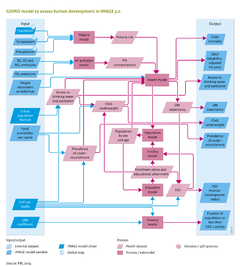Human development: Difference between revisions
Jump to navigation
Jump to search
No edit summary |
No edit summary |
||
| Line 1: | Line 1: | ||
{{ComponentTemplate2 | {{ComponentTemplate2 | ||
|Application=OECD Environmental Outlook to 2050 (2012) project; Roads from Rio+20 (2012) project; | |Application=OECD Environmental Outlook to 2050 (2012) project; Roads from Rio+20 (2012) project; | ||
|IMAGEComponent=Drivers; Energy demand; Agricultural economy; Emissions; | |IMAGEComponent=Drivers; Energy demand; Agricultural economy; Emissions; Water | ||
|ExternalModel=GUAM model | |||
|KeyReference=Hilderink and Lucas, 2008; PBL, 2012; | |KeyReference=Hilderink and Lucas, 2008; PBL, 2012; | ||
|InputVar=Temperature - grid; Precipitation - grid; Food availability per capita; GINI coefficient; GDP per capita; People dependent on solid fuel; BC, OC and NOx emissions; SO2 emissions; Population - grid; Urban population fraction; | |InputVar=Temperature - grid; Precipitation - grid; Food availability per capita; GINI coefficient; GDP per capita; People dependent on solid fuel; BC, OC and NOx emissions; SO2 emissions; Population - grid; Urban population fraction; | ||
Revision as of 08:58, 20 May 2014
Parts of Human development
| Component is implemented in: |
|
| Related IMAGE components |
| Projects/Applications |
| Models/Databases |
| Key publications |
Key policy issues
- What are the key future trends in human development, such as those targeted by the Millennium Development Goals (MDGs)?
- How are changes in the global environment likely to affect human development?
- How is improved access to food, water and energy likely to contribute to human development?
